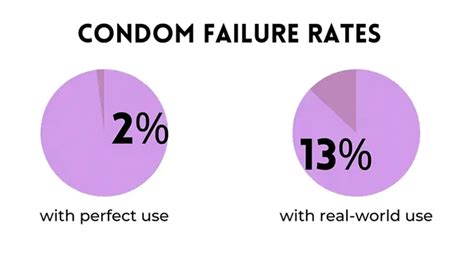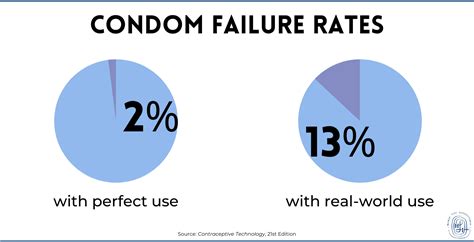Intro
The use of condoms is a widely recommended method for preventing the transmission of sexually transmitted infections (STIs) and unintended pregnancy. However, despite their effectiveness, condoms are not foolproof and can fail under certain circumstances. Understanding the reasons behind condom failure is crucial for individuals to make informed decisions about their reproductive health and to minimize the risks associated with sexual activity.
Condoms are a popular form of contraception due to their ease of use, affordability, and availability. They are also the only form of contraception that provides protection against both STIs and pregnancy. However, the effectiveness of condoms depends on various factors, including the type of condom used, the material it is made of, and how it is used. Despite proper use, condoms can still fail, and it is essential to be aware of the reasons behind these failures to minimize the risks.
The importance of understanding condom failure facts cannot be overstated. By knowing the reasons behind condom failure, individuals can take steps to reduce the risk of STIs and unintended pregnancy. This knowledge can also help individuals make informed decisions about their reproductive health and to choose the most effective method of contraception for their needs. Furthermore, understanding condom failure facts can also help to reduce the stigma associated with condom use and to promote a culture of safe and responsible sexual behavior.
What are Condoms and How Do They Work?

Types of Condoms
There are several types of condoms available, including: * Latex condoms: These are the most common type of condom and are made from natural rubber latex. * Polyurethane condoms: These are made from a synthetic material and are a good option for individuals with latex allergies. * Polyisoprene condoms: These are made from a synthetic material and are a good option for individuals with latex allergies. * Female condoms: These are designed to be inserted into the vagina or anus and are made from polyurethane or nitrile. * Lambskin condoms: These are made from the intestinal lining of lambs and are a natural, non-latex option.Reasons Behind Condom Failure

Condom Failure Rates
The failure rate of condoms varies depending on the type of condom and how it is used. According to the Centers for Disease Control and Prevention (CDC), the typical use failure rate for condoms is around 15-20%. This means that out of 100 couples who use condoms as their primary form of contraception, 15-20 will experience an unintended pregnancy within the first year of use.Preventing Condom Failure

Alternatives to Condoms
For individuals who are concerned about condom failure, there are several alternative methods of contraception available, including: * Birth control pills: These are a popular form of hormonal contraception that can be taken daily to prevent pregnancy. * Intrauterine devices (IUDs): These are small devices that are inserted into the uterus to prevent pregnancy. * Implants: These are small rods that are inserted under the skin to release hormones that prevent pregnancy. * Diaphragms: These are dome-shaped devices that are inserted into the vagina to prevent pregnancy.Common Condom Failure Myths

Condom Failure and STIs
Condom failure can increase the risk of STIs, including chlamydia, gonorrhea, and HIV. According to the CDC, condoms can reduce the risk of STIs by up to 70%. However, if a condom fails, the risk of STI transmission increases.Condom Failure and Pregnancy

Emergency Contraception
For individuals who experience condom failure, emergency contraception is available. Emergency contraception can be used to prevent pregnancy after unprotected sex. There are several types of emergency contraception available, including the morning-after pill and the copper IUD.Conclusion and Next Steps

We invite you to share your thoughts and experiences with condom use in the comments below. Have you ever experienced condom failure? What steps do you take to minimize the risk of condom failure? Share your story and help us promote a culture of safe and responsible sexual behavior.
What is the most common reason for condom failure?
+The most common reason for condom failure is incorrect use. This includes not putting on the condom before sexual activity, not leaving enough space at the tip of the condom, and not using enough lubricant.
Can condoms be reused?
+No, condoms should not be reused. Reusing a condom can increase the risk of failure and the transmission of STIs.
What is the typical use failure rate for condoms?
+The typical use failure rate for condoms is around 15-20%. This means that out of 100 couples who use condoms as their primary form of contraception, 15-20 will experience an unintended pregnancy within the first year of use.
